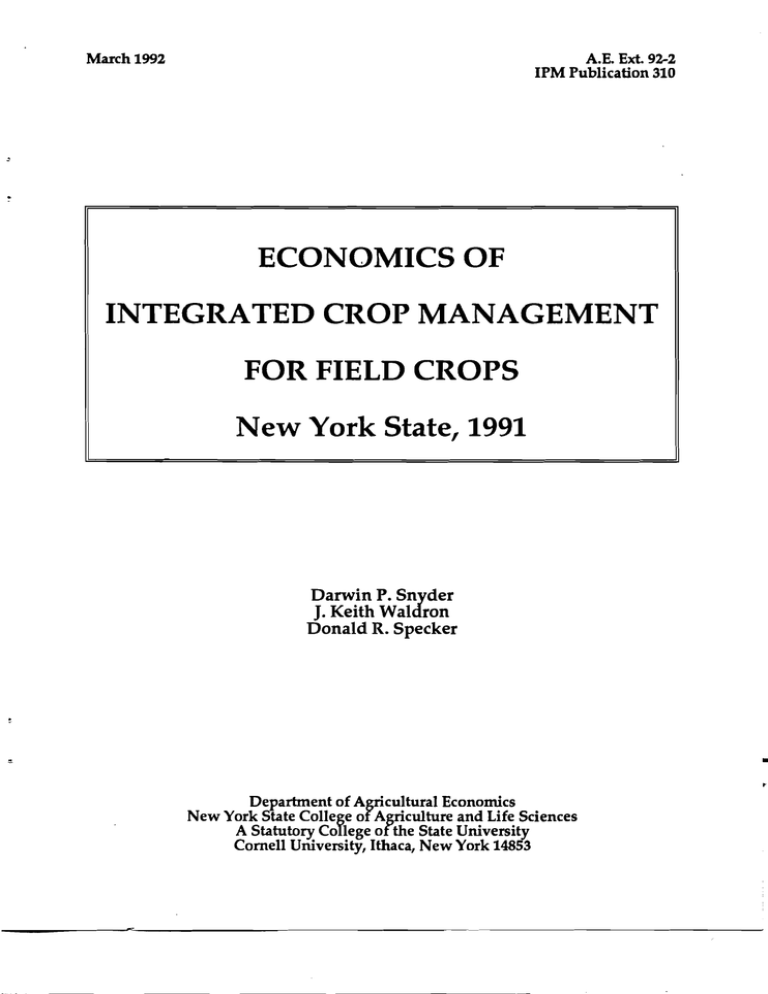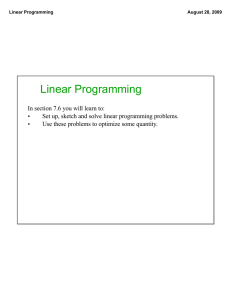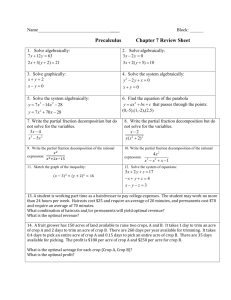Document 11949912
advertisement

March 1992 A.E. Ext. 92-2 IPM Publication 310 ECONOMICS OF INTEGRATED CROP MANAGEMENT FOR FIELD CROPS New York State, 1991 Darwin P. Snyder J. Keith Waldron Donald R. Specker • Depamnent of Agricultural Economics New York State College of Agriculture and Life Sciences A Statutory College ofthe State University Cornell University, Ithaca, New York 14853 ECONOMIC IMPLICATIONS OF INTEGRATED CROP MANAGEMENT PRACTICES FOR FIELD CROPS D. P. Snyder J. K. Waldron D. R. Specker* Introduction In recent years, the environmental aspects of agriculture have received increasing attention in New York and elsewhere. Concern over protecting the environment, including ground and surface water, have ~ven rise to programs such as Integrated Pest Management (IPM). This program seeKs to encourage farmers to apply a holistic management approach to pest control. This approach utilizes a variety of compatible techniques to best manage a specific pest problem at a given time or, where possible, avoid the pest problem altogether. When pesticides are necessary to maintain crop yields and quality they are judiciously employed in an environmentally responsible manner. The potential effects of other agricultural inputs and practices on the environment have also been recognized. Thus, practices including soil conservation, inorganic fertilizer use and the use of animal wastes and crop resinues have been scrutinized for their effects on environmental quality. The application of known and developing technologies to protect soil and water resources involves the transfer of knowledge and research results to the producer. Ideally, these production practices would lead to a refinement of strategic crop management plans (long term) and operational crop management plans (short term) and result in an optimum use of available technology to enhance the environment as well as the profitability of agriculture. The emerging perspective of inte~ated crop management seeks to provine farmers with a cropping strategy that incfudes all appropriate crop production practices, including the use of IPM, to optimize the profitability and environmental efficiency of crop production. Background The Integrated Pest Management program has been available to farmers in New York State for several years. Since 1982, 35 New York counties have implemented dairy and field crop IPM programs for alfalfa, field com, small grains or dairy cattle. Programs in Chautauqua, Cattaraugus and Cortland Counties, among others, have placed particular attention on addressing IPM and nutrient management components. The Cortland County project will be the principle focus for this report. A crop management program, which included IPM techniques, was begun in 1983 in Chautauqua and Cattaraugus Counties in the southwestern part of the state. Data from crop records for 1984 to 1986 were used to assess the economic impact of formally managing pesticide and fertilizer use on participating farms (Waldorph and Lazarus, 1988). This work indicated that crop input costs decreased by $12 and $8 per acre on twelve Chautauqua County and four Cattaraugus County farms respectively. The largest impact was shown to be in the form of reduced fertilizer costs for hay and com crops. ·The authors are, respectively, Research Associate, Department of Agricultural Economics, Cornell University, Ithaca, New York; Extension Associate and IPM Coordinator for Dairy and Field Crops, Cornell University, Ithaca, New York; and former Regional Extension Specialist for Field Crops, Cortland County, New York. • 2 An IPM program was begun with ten dairy farmers in the central Southern Tier region of New York in 1989. The overall potential benefits to farmers participating in this IPM program were enhanced by the inclusion of nutrient management components. These farms enrolled a total of 282 acres of corn and 391 acres of alfalfa hay. This first year program was considered transitional in regard to adopting the recommendations and evafuation of results. Although pesticide use records were difficult to obtain for analysis. growers did exhibit a high level of compliance for implementing various pest control actions such as early harvest or pesticide treatment based on need detennined by timely field sampling. It was also apparent from data comparisons that substantial reductions in nutrient use on established alfalfa fields did occur. The central Southern Tier program was expanded in 1990 to include more farms and acres. Thirteen farms were enrolled in Cortland County. Records kept for these farms were complete and accurate enough to be used for an initial analysis (Snyder and Waldron. 1991) of the effects of recommended crop management practices on input costs and farm profitability. These 13 farms were participants in the ASCS SP-53 Integrated Crop Management ClCM) program which includes IPM and nutrient management components. In 1991. the program continued with most of the same 13 farms for a second year. Some fields were added to the program; some were not included for 1991. In all, 14 farms with a total of 1.494 acres were enrolled. This represented an increase of 227 acres over the 1990 acreage in the study. All pesticides used were chosen for their minimal effects on water quality with outstanding grower compliance. Each of the fields treated with a pesticide had either a small or medium rating for leaching or runoff potential, whichever was relevant. Plant nutrient inputs were determined by soil testing and consideration of manure applications and crop rotational plans. Purpose and Objectives The purpose of this report is to summarize and analyze the economics of cultural practices that were changed as a result of enrolling in the second year of an integrated crop management program. This report will also serve to document the 1991 results and provide a standard for comparison with the results with similar data obtained for future years. Another objective is to illustrate the economic implications that may be expected from a carefUlly managed program of field crop cultural practices aimed at both resource protection and enterprise profitability. Methodology Fourteen farms in Cortland County were enrolled in the 1991 Integrated Crop Management ClCM) program. The crops enrolled in the program included alfalfa hay and field corn totalling 1,494 acres. The hay crop was divided into new seedings and established stands because of significantly different cultural practices. Records included the type and quantity of fertilizer and pesticides applied to each field. The program was administered by Cooperative Extension and on-site crop conditions were regularly monitored by scouts. As in 1990. records for each field indicated the farmer's conventional "Pre_program" practices regarding pest control and fertilization. These practices served as a base against which"Actual" practices were compared to determine the size of differences in input costs. Fertilizer nutrients were calculated in terms of pounds of nitrogen. phosphorus and potash (N-P-K) applied per acre. Pesticides used were recorded by product and rate applied per acre. Prices for these crop inputs were obtained from" 1991 Budget Guide" (Snyder. 1991). For each crop. fertilizer and pesticide costs per acre were calculated for each farm and averaged. Costs were compared for the "Pre-program" and the "Actual" applications in each case. Custom rates were used to measure costs affected by changes in the number of pesticide or fertilizer applications. Finally. these cost • 3 differences were weighted by acres of each crop to determine the average difference in cost per acre between "Actual" applications and "Pre-program" applications. Another group of farms was used to estimate the potential economic effect of these practices. Average acreages of hay and corn on 395 farms in the 1990 Dairy Farm Business Summary (Smith, et. al., 1991) were used with the cost differences per acre to estimate a weighted average difference in cost per acre for all hay and corn acres. Scouting and sampling procedures involve time in the field to assess the need for and success of the pest and nutrient management program. These formal procedures are part of an ICM program and result in additional costs to the grower. An estimated cost for these practices is used to provide a reasonable indication of posSible economic benefits of practices that include both pesticide and nutrient management. Results The 14 Cortland County dairy farms in the 1991 ICM program enrolled varying acreages of hay and corn crops. Records for the enrolled fields provided data for fertilizer and pesticide application practices that are summarized in the following tables. The economic effect of changes in practices is measured by differences in costs per acre calculated for "Pre-program" and "Actual" applications. Following program recommendations resulted in cost reductions for fertilizer for all crops. Pesticide costs were reduced for hay crops but showed a small increase for field corn. In the first analysis, costs were calculated for all 14 farms for fertilizer use (Table 1) and for pesticide use (Table 3). A comparison shows a smaller reduction in cost per crop acre for pesticide use than for fertilizer use. With application costs included, fertilizer costs were reduced an average of $13.31 per crop acre while pesticide costs were reduced an average of $1.93 per crop acre. Table 1. Fertilizer Cost Reductions Between Pre-Program Use and Actual Use Under The Inte~ated Crop Management Program, 14 Farms, Cortland County, New YorK, 1991 Material Cost Per Acre Crop· Hay crops: New seeding Established Field com TOTAL Total Enrolled Acres PreProgram Actual Difference Material Application·· Per Acre $ $ $ 1,329 11,842 3,114 199 2,672 729 6.95 22.16 6.21 16,285 3,600 10.90 2.41 acres $ $ $ 220 655 619 20.47 22.01 26.48 14.43 3.93 21.45 6.04 18.08 5.03 1,494 Average cost reduction per acre Total Fertilizer Cost Reduction For Enrolled Acres ·New seedings - 20 fields on 11 farms Established seedings - 71 fields on 14 farms Field corn - 62 fie1<fs on 14 farms "A custom application rate was estimated at $6 per acre for those acres sprayed. 13.31 • 4 Fertilizer costs decreased $6.95 per acre for new seedings and $6.21 per acre for the corn crop in the ICM program. Fert1l1zer costs decreased most for established seedings in the program. Material costs were reduced from $22.01 to $3.93 per acre for established seedings. With fertilizer applied to fewer acres, fertilizer application and material costs were reduced an average of $22.16 per acre. When the cost differences were weighted by the number of acres for each crop, the overall cost reduction for fertilizer averaged $13.31 per crop acre for the 1,494 enrolled acres. This reduction is over double the $5.36 per acre lower cost for fert1l1zer shown in the 1990 study. Table 1 deals with changes in input costs resultinR: from changes in fertilizing practices on major field crops. It is also important to note cbanges in the quantity of plant nutrients applied that may result from following ICM recommendations. These differences are shown in Table 2 and illustrate improvements in nutrient management efficiencies. Table 2. Reduction in Plant Nutrient Use Between Pre-Program Use and Actual Use Under the Integrated Crop Management Program, 14 Farms, Cortland County, New York, 1991 Crop Total Enrolled Acres Nutrient Nutrient - Pounds Per Acre Difference Actual Pre-Program Hay Crops: New seeding 220 N P K Established 655 N P K Field Corn 619 N P K 18 38 57 14 34 25 -4 -4 -32 0 29 118 1 7 16 1 -22 -102 47 48 32 36 41 26 -11 -7 -6 These 14 Cortland County daily farms reduced nitrogen, phosphorus and potash for all crops with the only exception being a one pound per acre increase in nitrogen applied to established hay crops. The most significant decreases were realized for potash applied to new seedings and established hay crops. Reductions averaged 32 and 102 pounds per acre respectively for new seedings and established hay crops. Phosphorus was reduced by 22 pounds per acre also for established hay crops. Smaller nutrient reductions occurred for corn and for new seedings for the other nutrients. A comparison of actual and pre-program pesticide costs for 1991 shows a cost reduction for pesticide materials and application of $1.93 per crop acre (Table 3). This is a greater reduction than the $1.30 per acre shown in the 1990 study results. " . 5 Table 3. Pesticide Cost Reduction Between Pre-Program Use and Actual Use Under the Integrated Crop Management Program, 14 Farms, Cortland County, New York,1991 Material Cost Per Acre Crop· Total Enrolled Acres PreProgram acres $ OifActual ference $ $ 1.69 0.00 0.00 2.33 8.77 0.00 Total Pesticide Cost Reduction For Enrolled Acres Material Application·· Per Acre $ $ $ 513 1,929 0 2,442 611 13.88 114 0.36 -439 30 -0.66 2,127 755 1.42 0.51 Hay Crops: NeWSeed~s 220 Herbicie Insecticide Fungicide Totals Established Herbicide Insecticide Fungicide Totals Field Com: Herbicide Insecticide 4.02 8.77 0.00 ~ ITlO 0.00 0.19" 0.00 0.19 0.00 0.00 0.00 0.00 0.19 0.00 655 0:00 0:19 0 124 0 124 21.60 0.02 0.00 2T:62 -0.75 +0.04 0.00 -464 25 0 619 20.85 0.06 0.00 Fun~cide 2O:9T otals TOTAL 12:"'79 1,494 Average cost reduction per enrolled acre :o:7T 1.93 ·New seedings - 20 fields on 11 farms Established seedings - 71 fields on 14 farms Field com - 62 fielcfs on 14 farms uA custom application rate was estimated at $6 per acre for those acres sprayed. The greatest cost reduction occurred in pesticide materials applied to new seedings. For fhis crop. pesticide costs were reduced from $12.79 to $1.69 per acre. Seventy-nine percent of these savings, or an average of $8.77 per acre, were accounted for by reductions in insecticides. Total cost reduction for new seedings was $13.88 per acre including application of the pesticides. Only a small savings 0[$0.36 per acre was realized for established hay crops and total pesticide costs increased by $0.66 per acre for the com crop. In each case, efficiency in pest control was improved through identification of pests, regular monitoring, and selection of the most appropriate management alternatives, including, but not limited to, use of carefully selected pesticides. From the experience of the 14 dairy farmers participating in the 1991 Cortland County ICM program, participation resulted in average savings of material and application costs of$15.24 per crop acre enrolled. Most of the cost reductions were realized from changing fertilizer applications especially on established seedings. The greatest reductions for pesticide use was for new seedings. As shown in Tables 1 and 3, fertilizer costs were reduced by $13.31 per crop acre and pesticide costs decreased by $1.93 per crop acre. These results indicate greater savings for program participants in the second year of ICM program participation. Table 4 combines the results of the fertilizer and pesticide cost reductions shown in the 1991 study. With an estimated cost of $10 per acre for ICM scouting, soil testin~ and related items, it is apparent that economic benefits may be realized along witb environmental benefits through informed management practices. • 6 Table 4. Changes in Fertilizer and Pesticide Costs Resulting From The Cortland County Integrated Crop Management Program 14 Farms, Cortland County. New York. 1991 Total Enrolled Acres Crop Fertilizer Cost Reduction Total Per Acre 220 655 Field com 619 TOTAL 1,494 $ $ 1.528 14,514 6.95 22.16 3,053 238 13.88 0.36 4,581 14,752 20.83 22.52 3,843 6.21 -4.09 -0.66 3,434 5.55 $ 19.885 Average cost reduction per acre Estimated ICM cost per acre· $ Total Cost Reduction Total Per Acre $ acres Hay crops·: New seeding Established Pesticide Cost Reduction Total Per Acre 22,767 2.882 13.31 $ 1.93 15.24 10.00 Estimated net benefit per acre 5.24 ·Hay crop - Acreage assumed to be 20% new and 80% established seedings. Field corn - Includes silage and grain com. ICM cost - Includes scouting, soil tests. records. etc. In a second analysis, crop data were used from the 1990 New York State Daily Farm Business Summary to illustrate the effect similar changes might have on daily farms represented by a larger group of farms. Table 5 shows the results when average hay and corn acreages are used from those 395 New York dairy farms. The table uses the cost reductions per acre for fertilizer and pesticide use on the 14 Cortland County farm participants for 1991. Table 5. Estimated Changes in Fertilizer and Pesticide Costs Using Cortland County Intetated Crop Management Pro§ram. Results for Average Crop Acres on 395 aily Farms, New York. 199 Crop Hay crops·: New seeding Established Total Crop Acre Per Farm Fertilizer Cost Reduction Per Farm Acre $ acres Pesticide Cost Reduction Per Farm Acre $ $ $ Total Cost Reduction Per Farm Acre $ $ 33 132 229 2,925 6.95 22.16 458 48 13.88 0.36 687 2.973 20.83 22.52 Field com 121 751 6.21 -80 -0.66 671 5.55 TOTAL 286 3,905 Average cost reduction per acre Estimated ICM cost per acre· 4,331 426 13.65 1.49 Estimated net benefit per acre ·Hay crop - Acreage assumed to be 20% new and 80% established seedings. Field com - includes silage and grain com. ICM cost - includes scouting, soD tests, records. etc. 15.14 10.00 5.14 I I I L 7 From these data, it appears that ICM practices would reduce fertilizer costs somewhat more and pesticide costs somewhat less for the larger group of dairy farms than for the 14 Cortland County farm group. However, the overall cost reductions were essentially the same for both groups at $15.14 and $15.24 per crop acre, respectively. There was an average of 286 acres of hay and com crops on 395 dairy farms in the 1990 Dairy Farm Business Summary program. Table 5 shows cost reductions of $3,905 and $426 per farm for ICM changes in fertilizer and pesticide practices respectively. The total cost reduction of $4,331 per farm or $15.14 per acre is enough to cover scouting and soil test costs at $10 per acre. In addition, other benefits may occur by considering the effects of other factors discussed below. Other Considerations Information presented in this progress report compares pesticide and fertilizer use expenditures for "Pre"-program and "Actual" use for participating farmers. In many situations, "Pre"-planned activities and "Actual" use (based. on quantifiable need) were identical. In other cases, "Pre"-plan activities and "Actual" inputs varied and were considerably affected by timely scouting data and actual soil test information. It is anticipated that the most consistent benefit from participation in this type of program will be the impact of timely, individualized information on improving management decisions. This will be reflected in financial returns on pesticide ana fertiliZer use and in changes to yield or quality. Additional benefits, however, may accrue that are not reflected in this economic analysis. These "hidden" benefits include improvements to a variety of crop protection and production activities that would tend to enhance overall profitability for the participants. These benefits include detailed records which document various pest and crop production actiVities, inputs, actions, and impacts. Other activities or "spin-offs" include improvements for the timing of management actions, identification of specific cropping problems which enable farmers to modify cropping strategies such as choosing crop varieties resistant to identified diseases, improvements in hay quality and rotational decisions, and grower "peace of mind" due to availability of regularly scheduled, timely crop and pest information. It is anticipated that these factors will play an additional role in the long term benefits of participation in the ICM program for both the producer and the environment. Producers with contact and close proximity to research based information through cooperative extension or other "unbiased" agricultural information sources will experience additional "educational moments" for management problems, other than pests and nutrients, which may contribute to overall enhancement of crop production profitability. These factors may include greater attention to detail, early identification of specific problems, avoidance of unnecessary actions which save both time and expense, earlier planting and more timely harvest, etc. As quality improves for feed crops, livestock profitability may also improve. BIBLIOGRAPHY Waldorph, Joanne and Lazarus, William F., "Economic Impacts of the Crop Management Program on Western New York Dairy Producers", A.E.Res. 88-11, Department of Agricultural Economics, Cornell University, Ithaca, NY, Sept, 1988. Snyder, Darwin P. and Waldron, J. Keith, "Economics of Integrated Crop Management for Field Crops, First Year Results", IPM Publication 308, Cornell University, Ithaca, NY, April 1991. Snyder, Darwin P., "1991 Budget GUide", A.E.Res. 91-2, Department of Agricultural Economics, Cornell University, Ithaca, NY, April 1991. Smith, S.F., Knoblauch, W.A. and Putnam, L.D., "New York Dairy Farm Management Business Summary, 1990", A.E.Res. 91-5, Department of Agricultural Economics, Cornell University, Ithaca, NY, August 1991. • OTHER AGRICULTURAL ECONOMICS EXTENSION PUBLICATIONS " No. 91-27 Pro-Dairy Financial Data Collection Workbook Jonas B. Kaufman Stuart F. Smith Linda D. Putnam No. 91-28 Income Tax Myths, Truths, and Examples Concerning Farm Property Dispositions Stuart F. Smith No. 91-29 Farm Income Tax Management and Reporting Reference Manual George L. Casler Stuart F. Smith No. 91-30 Considerations in Establishing Retirement Plans for Farm Employees George Casler Tom Maloney No. 91-31 Item Pricing in New York state: A Three Phase study Focusing on Price Systems, Accuracy, Consumer Perception and Related Costs to the Food Industry Gene A. German Debra J. Perosio No. 91-32 New York Economic Handbook 1992 Agricultural situation and Outlook Extension Staff No. 91-33 1990 Northeast Beef Farm Business Summary Caroline Nowak Rasmussen Danny G. Fox Stuart F. Smith Ted C. Perry No. 91-34 Issues in the Development and Marketing of Reduced Chemical Agricultural Products: A Look at Disease-Resistant Apple Cultivars Cecile Murphy Lois Schertz Willett No. 92-01 Economics of Integrated Pest Management Practices for Insects in Grape Production Darwin P. Snyder Timothy H. Weigle Gerald B. White • •




